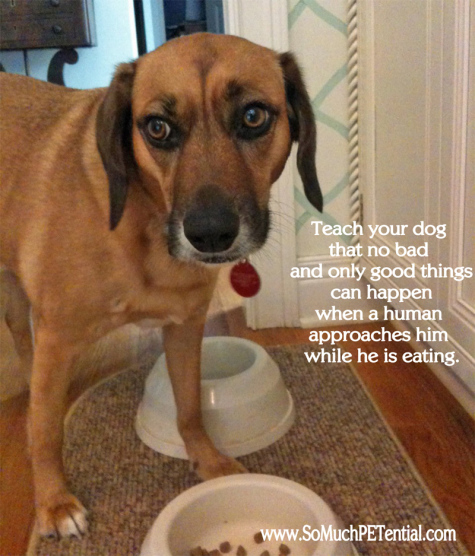The other day I saw a scenario I have seen before.
A golden retriever was laying on the ground working on a stuffed Kong. He was perfectly content, with relaxed body muscles, until the moment a human walked up to take his possession away.
As the person approached, the dog began clenching his toy harder as his muscles tensed, he looked up with the whites of his eyes showing around the edges and his ears went back. Since the person did not heed his early warning and back away, a low growl began to come from deep inside as his eyes fixed on the unwanted guest approaching too close for comfort at that particular moment.
In this case, the dog’s owner backed off when the dog growled and the dog went back to relaxing his body muscles and focusing on his toy. (Then we talked about what was going on and how to work through it with desensitization/counterconditioning to set everyone up for success.) However, if the owner had not backed off and simply took the toy away, there is no telling whether the dog would have escalated his behavior as his only means of communicating to humans that he does not want them taking his prized possessions (because obviously, from his point of view, humans do not understand his non-aggressive communication).
It is important to know resource guarding is not unusual in dogs. It can range in intensity, and also can be directed toward certain people or other dogs.
If you have a dog or puppy who is already showing strong resource guarding tendencies, please do not punish your dog for communicating that does not want you approaching as that will not remove your dog’s underlying emotional response to your approach. Instead, it has the potential to actually exacerbate the problem as your dog will have more reasons to associate your presence near his guarded food or object as something negative.
Manage the situation by leaving your dog alone while eating, managing access to items that your dog has a tendency to guard, or feeding your dog behind a barrier and seek professional help from a trainer who uses positive reinforcement based strategies.
Don’t have a resource guarder yet? Great! Now is the time to prevent it.
While there are never any guarantees in life, you will go a long way by teaching your puppy or dog early in your relationship to have a positive association between you and his food. For the first few weeks (or longer depending on circumstances) your new addition is with you, save at least half of his daily food allotment for either hand feeding or to be used as training reinforcers.
Also, teach your dog or puppy that only good things happen when a human appears while he is eating or has a chew toy. To do this, give him a little food in his bowl (or chew toy), walk by and drop a piece of valuable food (like meat or chicken) next to his bowl (or toy) and keep walking. If your puppy stops eating and begins to follow you, ignore him and wait for him to go back to his bowl and try again. You want your puppy to have a positive response to your approach. Then practice picking up his food bowl or toy, putting a yummy treat in it and placing it back on the floor (or if it is a toy, just hand him back the toy). Practice this with different people and children. Remember to never take his possession away from him without giving him something better in return.
A good skill to teach your new companion is ‘drop it’. Please click here to read my post on several ways for teaching it.
Remember, if your pet is already showing resource guarding, please seek professional help.






